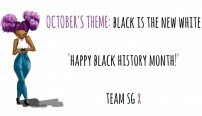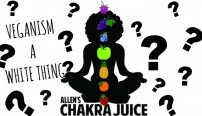This week Solange Knowles released her new, very timely, pro-black album, beautifully entitled “A Seat At The Table”. With it, she not only set trends but particularly in her single “Don’t Touch My Hair” she definitely sets her boundaries.
“Don’t Touch My Hair” is a perfect illustration of the division line Solange is putting up throughout the song, but what exactly is she protecting?
Keeping reading as I decode…
“Don’t Touch My Hair” is something I’m sure every girl wants to shout when we see an unfamiliar hand go for the fro; because let’s face it, nobody likes to be stroked like a stray wild cat in a petting zoo by a complete stranger.
However, there’s no denying that this is probably more of an issue for African-Caribbean girls (political identity: Black girls), especially when the hand reaching for our crowns belongs to someone of a different race. I say‘our’ because I am of African-Caribbean descent and from my experience I never really know whether they want to touch my hair out of pure curiosity, sheer awe, admiration or if their request is coming from a place of belittlement, humiliation and pity.
[Verse 1: Solange]
Don’t touch my hair
When it’s the feelings I wear
Don’t touch my soul
When it’s the rhythm I know
Don’t touch my crown
They say the vision I’ve found
Don’t touch what’s there
When it’s the feelings I wear
Here we see Solange describe her hair as; her ‘feelings, soul, rhythm, crown and vision.’ Its clear from this verse that Solange sees her hair as an extension of who she is – so is the case with many people. Hair can give a sense of identity, and for some can even have spiritual connotations- hence Solange says “Don’t touch my soul”, she sees her hair as something much deeper than just hair. It is an extension of her innermost being.
Remember when India Arie said “I am not my hair”?Well its as if this song is saying “I am not my hair, but my hair is me”.
Note: The word ‘touch’ throughout this song is not necessarily talking about just a touch, she could be meaning don’t mess with it and don’t change it. Solange is known for often rocking her natural gorgeous Afro hair, but in the music industry its possible that she’s seen or even experienced her fair share of dictation on how she should portray herself in the media spotlight. DTMH is Solange’s prominent message to the world to not regulate how she wears her hair in an attempt to downplay her blackness. PREACH SISTER!
[Pre-Hook: Solange]
They don’t understand
What it means to me
Where we chose to go
Where we’ve been to know
They don’t understand
What it means to me
Where we chose to go
Where we’ve been to know
In this pre-hook ‘They’ are people outside of the African-Caribbean race, mainly – Caucasian people(people of European origin (political identity: white). Solange is saying that they don’t understand what her hair means to her, they don’t understand that to her, her hair signifies everything that she mentioned in the first verse.
She is also saying that they don’t understand what we as a race have been through with our hair. Our hair has a very deep history that we still see repeated in today’s world; not being seen as professional if we wear our hair natural, and recently not being able to wear natural hair to school in some countries. ‘Where we chose to go’ could be reference to ‘them’not understanding the reasons behind why we have done certain things with our hair; why have people chosen to relax, loc, straighten, hide, cainrow or cut their hair? Choosing to have these things done to our hair tend to have a reason behind and other races just wouldn’t understand.
‘Where we have been to know’I feel like Solange is talking about‘them’not understanding all of the things we have experienced regarding our hair that highlights their ignorance.
[Hook: Solange]
You know this hair is my s***
Rode the ride, I gave it time
But this here is mine
You know this hair is my s***
Rode the ride, I gave it time
But this here is mine
In this hook we see Solange taking ownership of her hair.
‘Rode the Ride’is pointing to all the hard work it takes to maintain natural hair. ‘I gave it time’ talks of the patience it requires too.
Both lines could also be talking of Solange’s hair journey and the transition more and more women of African-Caribbean descent are going through when going from chemically relaxed hair to their own naturally beautiful God-given hair.
[Post-Hook 1: Sampha & Both]
What you say, oh?
What you say to me?
What you say to me?
What you say to me?
What you say to me?
What you say to me?
What you say to me?
What you say to me?
What you say to me?
In this post-hook, it seems as though Solange can hear what outsiders and naysayers have to say but she is purposely choosing to ignore them. By repeating ‘What you say to me’it gets to a point where the opinion giver has to start questioning themselves, “What am I saying to her?”.
Note: This repeats again in another hook and also again in the outro.
[Verse 2: Solange]
Don’t touch my pride
They say the glory’s all mine
Don’t test my mouth
They say the truth is my sound
Here Solange has swapped hair for pride, she has fully accepted her hair for what it is, it is her crown and she wears it with pride. YAASSS!
“They say the glory’s all mine”reminds me of the Bible scripture where hair is described as a‘woman’s glory and covering.’ (1 Corinthians 11:15)
“Don’t test my mouth” – here she’s saying don’t try and shut her truth up which is followed by “They say the truth is my sound” which feels like she is saying don’t ask my opinion if you don’t want the truth or better yet can’t handle it!
That sums up the key lyrical points of the song, now lets look at some key parts of the accompanying video…
In the first scene we see Solange shaking her head, her hair swinging from left to right. It is as if her hair is saying “No don’t touch me” too. Some of her braids have beads all the way up, I can’t help but think that they are there to physically represent the barriers and limits that Solange is setting with the song.
In this scene we see Solange and the men behind her taking a brave and protective stance as if ready to fight anyone that tries to cross the barriers she is setting.
Here we see individuals dancing and couples touching on another very gently, this scene could be representing the intimacy that hair touching can entail, especially when you see it as an extension of your soul.
This scene sees Solange and featured artist Sampha dancing around freely whilst singing“What you say to me?”, the carelessness of their movement represents them not caring and not being suppressed by the opinions of others.
I feel as though this scene is a direct slap in the face to the stereotype that all women of African-Caribbean descent are afraid of getting their hair wet.
Thank you for reading this edition of Decoded! Remember, lyrics are like poetry, they can be interpreted in many different ways. How did you interpret this song?
Comment below!
















